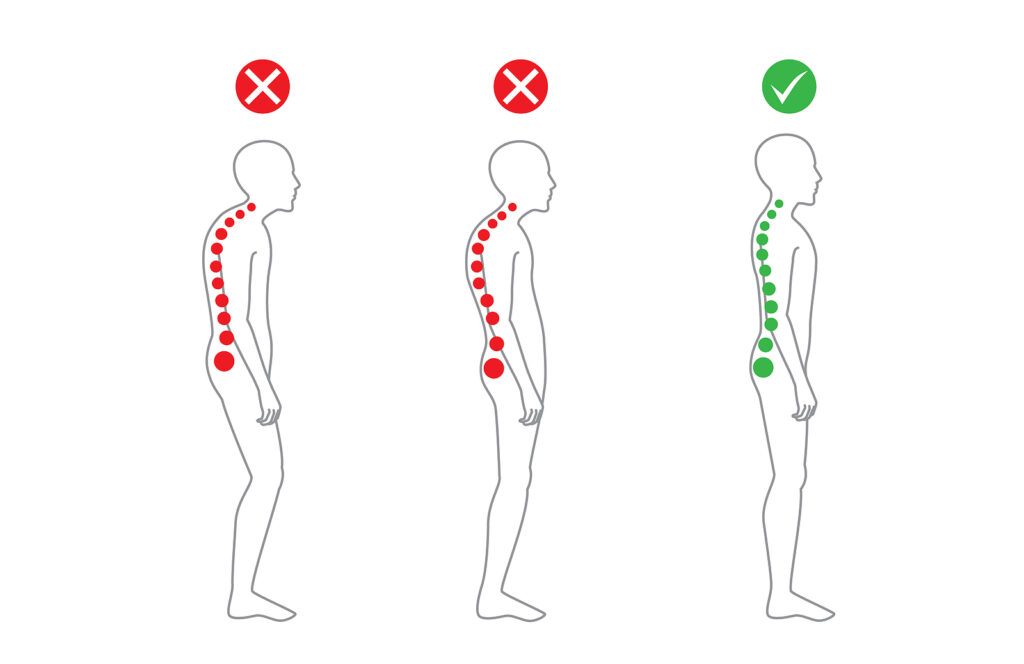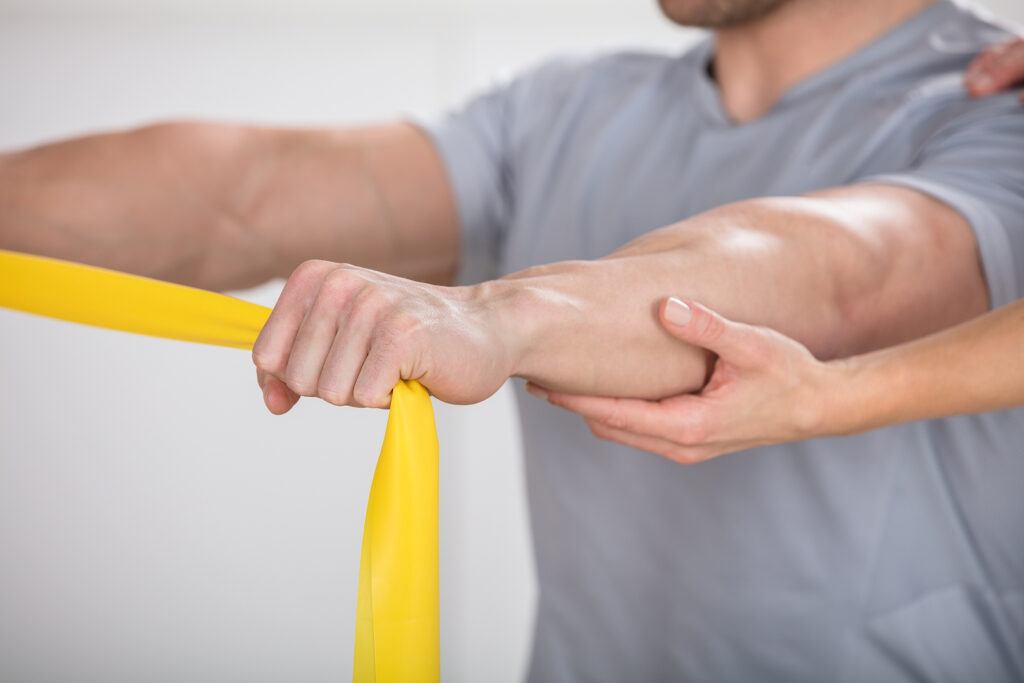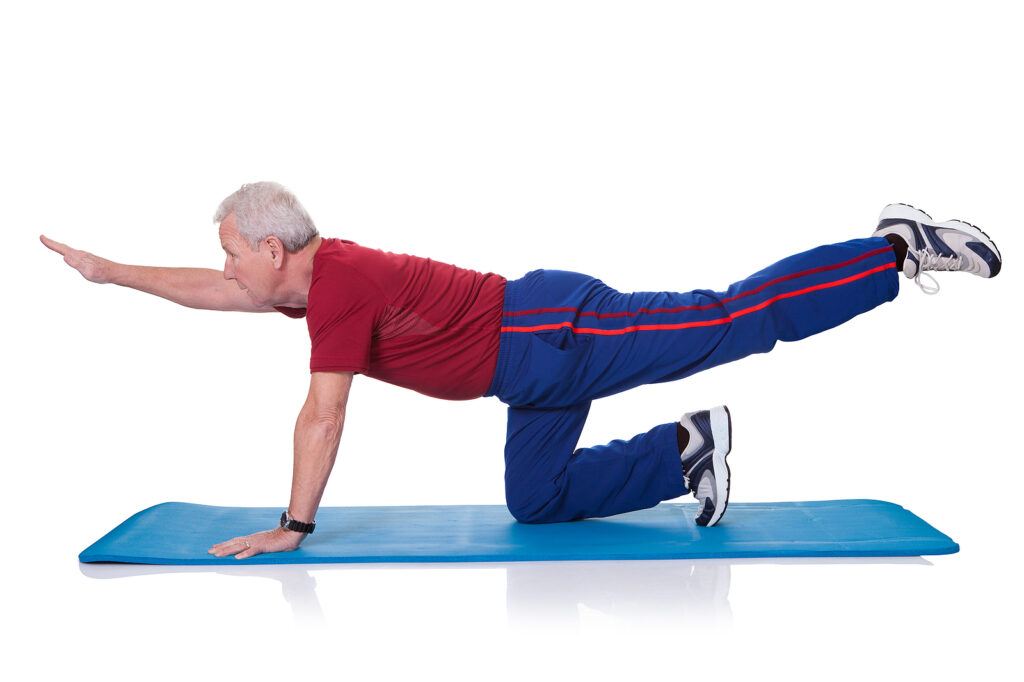Good posture is important for all of us, but it gets even more important as we age and become more susceptible to pain and mobility issues.
Over time, poor posture can lead to discomfort in the neck, back, and shoulders, but it can even affect breathing and digestion.
Poor posture can also lead to more permanent conditions like vertebral fractures, something I’m sure we’d all like to avoid.
There’s good news though – incorporating simple posture exercises into your routine can help realign your body and decrease the likelihood of these unwanted consequences.
In this article, we’ll discuss the best posture exercises for seniors that are safe, easy to do at home, and highly effective.
First things first though…
Why Is Good Posture Important for Seniors?
As we age, muscle strength and flexibility naturally decline, which can lead to a slouched or hunched posture. This can result in:
- Chronic Pain: Poor posture can cause strain on the spine and muscles, leading to discomfort in the back, neck, and shoulders.
- Reduced Mobility: Incorrect posture limits your range of motion, making daily activities like walking, bending, or even standing more difficult.
- Balance Issues: A slouched posture shifts your center of gravity, increasing the risk of falls and more serious injury.
- Decreased Lung Capacity: Slouching can compress the chest, reducing lung capacity and making breathing more difficult.
- Digestive Issues: Poor posture can also compress the organs, leading to digestive discomfort.
Maintaining proper posture can help alleviate these issues, improving not only your physical health but also your confidence and overall well-being.
What Causes Poor Posture?
The first step in knowing how to combat poor posture is understanding how it becomes an issue in the first place.
As we age, maintaining good posture can become increasingly challenging due to natural changes in our bodies.
Over time, muscle strength and flexibility begin to decline, and joint stiffness can set in, making it harder to hold an upright position.
Additionally, bone density tends to decrease, which can contribute to the development of conditions like osteoporosis, leading to a stooped posture.
This gradual weakening of the muscles and joints often results in slouching, rounded shoulders, or a forward head tilt, all of which can have serious consequences for overall health.
But there are non-age-related issues to blame for poor posture as well: the biggest of which is bad habit.
A lot of folks these days are used to sitting in front of a desk or computer for long stretches at a time, which tends to tighten the muscles in the front our neck/chest and weaken the muscles in the back.
Tight muscles in the front and weak muscles in the back are what we usually see when working with postural issues, so the key to improving posture is addressing these deficits.
A lot of seniors start moving less as well, meaning they’re sitting in chairs for long periods of time throughout the day.
All of this sitting (and lack of movement) can contribute to weakness in the back muscles and tightness in the front, leading to an exacerbation of poor posture.
So, to effectively improve posture, we should focus on stretching the tight muscles in the front of our chest/neck and strengthening the muscles in our back.

Safety Tips Before You Start
Before beginning any new exercise routine, it’s important to take some precautions to ensure you’re stretching and strengthening your body safely:
- Consult Your Doctor: If you have pre-existing health conditions or mobility concerns, talk to your doctor before starting new exercises.
- Warm Up: Always start with a light warm-up, such as walking or gentle marching in place, to prepare your muscles for exercise.
- Go Slow: Focus on performing each movement with control and good form, rather than rushing through the exercises.
- Use Support: If needed, perform these exercises near a sturdy chair or wall for added balance and support.
- Pain: You may feel some discomfort during the stretching, but you shouldn’t experience any sharp or lasting pain from these exercises. If you do, please discontinue that exercise or consult your local physical therapist for guidance.
The 10 Best Posture Exercises for Seniors
These posture exercises target the muscles in the back, shoulders, and core, which are essential for maintaining an upright posture.
The general goal is to stretch the tight muscles in the chest and neck and strengthen the weaker muscles in the back.
Aim to practice these exercises a few times a week for the best results.
1. Door Stretch
There are a lot of variations of this exercise (like the corner stretch), but the goal of all of them is to stretch the pec muscles in your chest.
Personally, I prefer to use a doorway, but feel free to try different positions to see what works best.
- Stand inside an open doorway and place your forearms on either side of the frame
- Keeping your arms at or slightly below shoulder height, gently lean forward into the doorway
- Hold for 20-30 seconds and relax
- Repeat 3-4x
The goal for this exercise is to feel a stretch in your chest without causing any shoulder pain – and I can tell you, sometimes it can be hard to accomplish this.
Feel free to play with your arm positioning – as long as you’re feeling a stretch in your chest (and not feeling pain), you’re doing it correctly.
You can also do this exercise with one arm at a time, which can be helpful when one shoulder is achier or stiffer than the other.
2. Single Arm Pec Stretch
This is another great exercise to stretch out your tight chest muscles, but it’s done one arm at a time and with a straight elbow.
You still need a doorway though.
- While in a standing position, grab the door frame with one hand and take a step away from it
- While keeping your arm straight, gently rotate your body away from the doorway
- Hold for 20-30 seconds and then switch to the other arm
- Repeat 3-4x for each side
Again, feel free to play with the height of your arm on the doorway to find what angle works best for you.
Most will feel the best stretch with the arm at about shoulder height, but if this isn’t comfortable, feel free to lower your arm.
3. Chin Tucks
This exercise is designed to directly counteract the forward head posture which so many of us deal with.
It can also be used to reduce neural pain or stretch the hard to reach suboccipitals, but that’s a story for another day.
This is a pretty straightforward exercise, but it can be surprisingly difficult to master.
- From either a standing or sitting position, start with good, upright posture
- Bring your chin in towards your neck, as if you were trying to make a ‘double-chin’
- Hold for a few seconds and then relax
- Repeat for sets of 10
The key to this exercise is to avoid bending your neck – your head should be going back toward your shoulders, not down toward your chest.
When done correctly, you’ll likely feel a nice stretch at the base of your skull.
4. Shoulder Blade Squeezes
Shoulder blade squeezes, aka scapular retractions, is a great exercise to start strengthening the muscles between your shoulder blades.
The above stretches help get your shoulders back where they should be, but we need to strengthen the muscles around them to help keep them there.
- From a seated or standing position, start with an upright posture, shoulders relaxed
- With your arms either down by your side or flexed to 90 deg at the elbow, squeeze your shoulder blades together in the back
- Hold for 5 seconds and relax
- Repeat for 3 sets of 10 or 2 sets of 15
The key to this exercise to make sure your shoulders don’t shrug while squeezing your shoulder blades together.
Focus on keeping your shoulders low and try to relax your neck throughout the movement.
5. Rows
The row is just a progression of the shoulder blade squeeze and it’s a nice way to add more strength to the muscles between your shoulder blades.
You can do this exercise without a resistance band, but adding a little resistance is helpful when possible.
- Attach band to doorknob or other secure location (if applicable)
- From a seated or standing position, start with shoulder low and relaxed, elbows bent at side
- Grab band handles and take a big step or two back, so that the band is taut
- Initiate the movement by squeezing your shoulder blades together in the back, while pulling your elbows in by your side
- Hold for a few seconds and then relax
- Repeat for 3 sets of 10 or 2 sets of 15
Again, this exercise is simply a shoulder blade squeeze against resistance, so make sure most of the action is coming from the shoulder blades.
And keep those shoulders low!

6. Band Pull-Aparts
This is a more difficult exercise, so if you have shoulder pain or significant shoulder range of motion limitations, it may not be a good option.
But if your shoulders are pretty healthy, it’s a great postural exercise to help combat the dreaded rounded shoulders.
And as the name implies, you need a resistance band for this one.
- From a seated or standing position, grab your band with an overhand grip, about shoulder-width apart
- Elevate arms to shoulder-height
- While keeping your elbows straight, squeeze your shoulder blades together while pulling your arms apart
- Pull until your arms are completely separated and hold for 3 seconds
- Slowly relax and return to your starting position
- Repeat for 3 sets of 10 or 2 sets of 15
This is a great exercise to strengthen the back of your shoulders and scapular stabilizers, but form is important.
Focus on initiating the movement with a strong shoulder blade squeeze and make sure your neck is relaxed and those shoulders aren’t hiking.
7. Wall Presses
You don’t need a resistance band for this one, but you do need a fair amount of shoulder mobility.
So, if you really stiff or achy shoulders, you’ll want to pass on this one.
- Stand with your back against a wall, feet about 6 inches away from the wall
- Keep your arms at a 90-degree angle, with your elbows bent and palms facing forward
- Slowly raise your arms overhead, keeping them in contact with the wall as much as possible
- Lower your arms back down to shoulder height, then repeat
- Aim for 2-3 sets of 10-15 reps
This is a great exercise for stretching out tight chest muscles and strengthening posterior shoulder muscles at the same time.
8. Back Extensions Against Wall
This is a straightforward exercise that doesn’t require any equipment (other than a wall), but it can be quite helpful for improving rounded shoulders and slouchy lumbar spines.
It’s also very low impact, making it a great starter exercise for seniors with more significant mobility or pain issues.
- Stand against a wall, feet about shoulder-width apart
- Arch your back as if you’re trying to push your shoulder blades and upper back into the wall
- Hold for 5-10 seconds and then relax
- Repeat for 2-3 sets of 5-10 reps as tolerated
Depending on your mobility, you can get a little extra bang for your buck during this exercise by including a chin tuck at the end.
If you’re able to get your head along the wall, try to stand tall and tuck your chin in as if you’re pushing the top of your head up toward the ceiling.
9. Up/Down from Chair
This isn’t a postural exercise per se, but it’s a great exercise for strengthening the hips – and the stronger your hips are, the better your spinal posture will likely be.
This is also easily my favorite exercise for seniors, so I try to find ways to include it in any home exercise program I’m setting up.
Anyway…
- Start seated in a comfortable, but firm chair
- Scoot to the edge and bring your feet just wider than shoulder-width
- Lean forward as you drive your feet down into the floor and stand up
- Once standing, squeeze your butt together and stand up as tall as possible
- Hold for a second and then slowly return to a seated position
- Repeat for 3 sets of 5-10 reps
You can use your hands to push off from the armrests if you need to, but this exercise because a lot more effective when done without using your hands.
If possible, start from a higher seat so that the transfers can be done with your legs only; you can progress by switching to a lower seat height as strength improves.

10. Bird-Dogs
The last exercise here is a core strengthening move, but it really gets the spinal extensors involved, which is helpful for improving upright posture.
This one also involves the lumbar muscles more, which often get forgotten when working on posture.
You have to be comfortable getting on your hands and knees for this, so this exercise won’t be for all seniors.
But if you can do it safely, it’s a great move to strengthen your back, core, arms, and help improve posture.
- Start on your hands and knees (use a yoga mat or soft carpet to protect your knees)
- Pull your belly button in toward your stomach and extend one arm and the opposite leg at the same time
- Hold for a second and then return to the starting position, repeat with the other arm/leg
- Repeat 10 times for each side, complete 2-3 sets of 10
How to Incorporate These Exercises Into Your Routine
For best results, aim to do these posture exercises 3-4 times a week.
You can perform them in the morning to start your day with good posture or in the evening to relieve tension after a long day.
These exercises can also be done in short sessions throughout the day, especially if you spend long periods sitting or standing.
I also want to point out that we went over a lot of exercises here, so don’t feel like you need to do all of them every time you exercise.
I’d recommend starting with 3-5 of them and see how they feel.
Feel free to switch things up regularly to see which exercises help the most.
Final Thoughts
Ok, that’ll do it.
We went over a lot of exercises here, but the funny thing is that I had a hard time narrowing this list down to only 10.
There are just so many different great postural exercises out there.
Which is good news for us because it means we have a lot of options to find the exercises that work best for us.
Anyway, good posture is key to staying mobile and maintaining overall health as we age.
Incorporating some these simple and effective posture exercises into your routine can definitely help improve your alignment.
But remember, consistency is important – these things take time, don’t expect immediate results.
Always listen to your body and if you experience chronic pain or have significant posture issues, it may be helpful to consult with a physical therapist.
They can provide personalized exercises and treatments to improve your posture and relieve discomfort.
Well, I hope you found this guide helpful and if you have any questions or comments, just leave ’em below and I’ll get back to you shortly.



